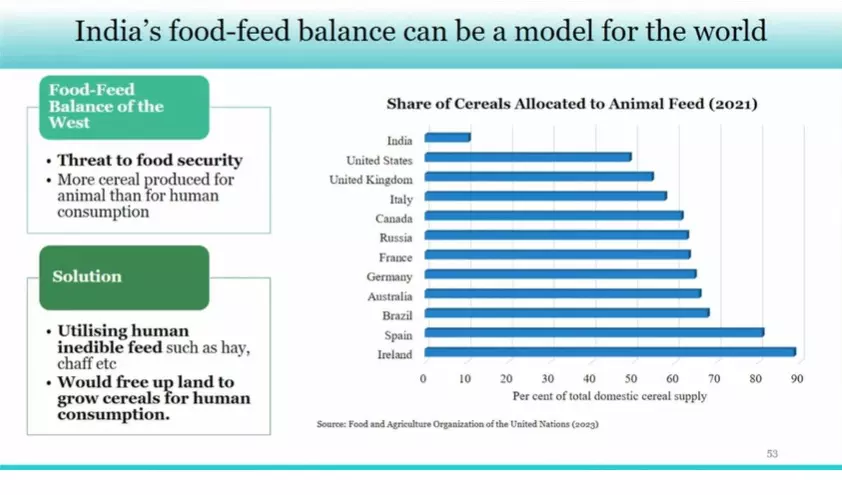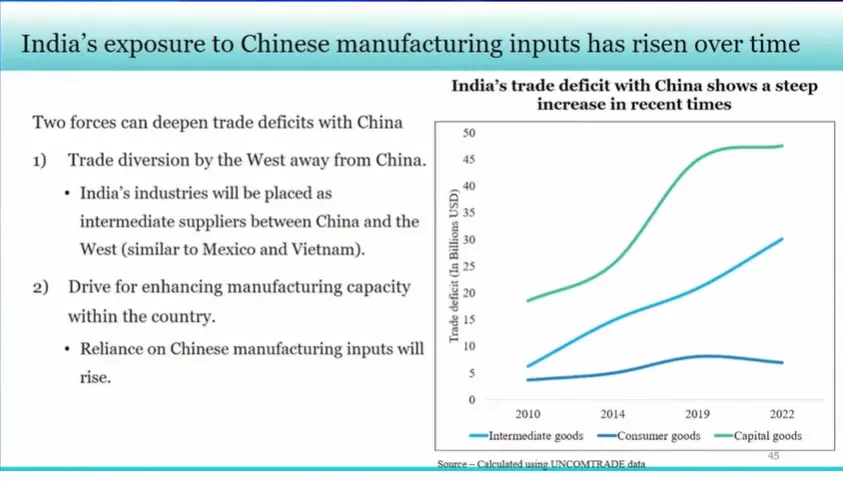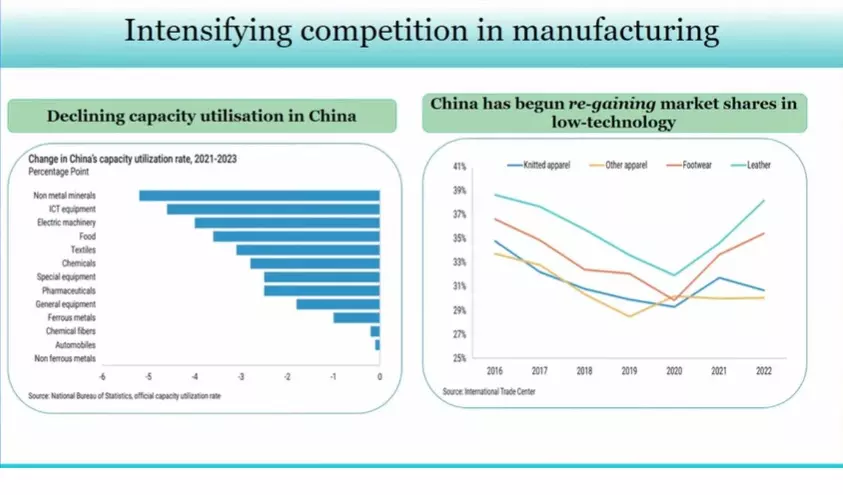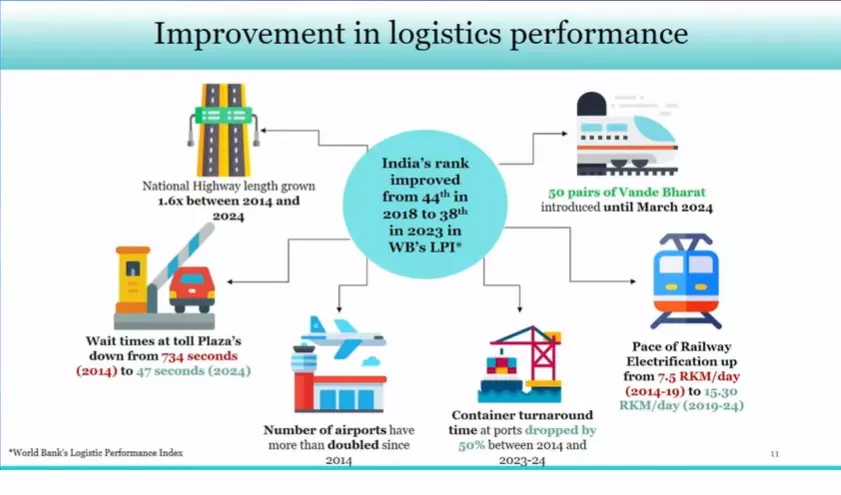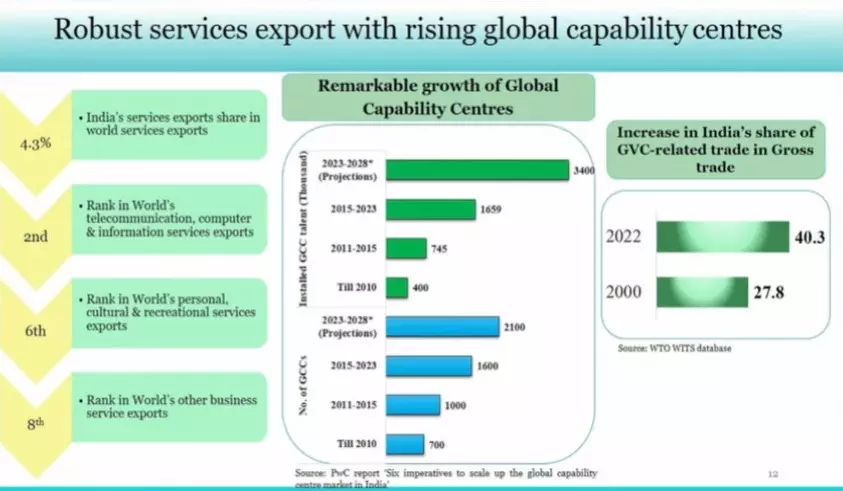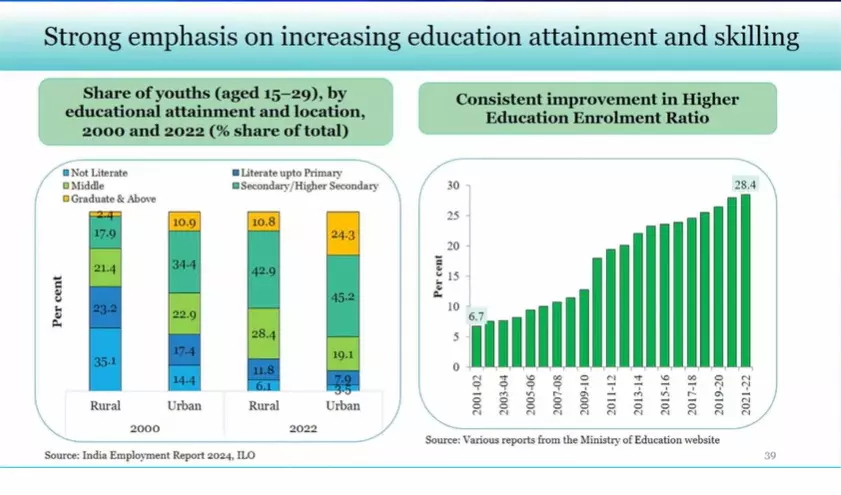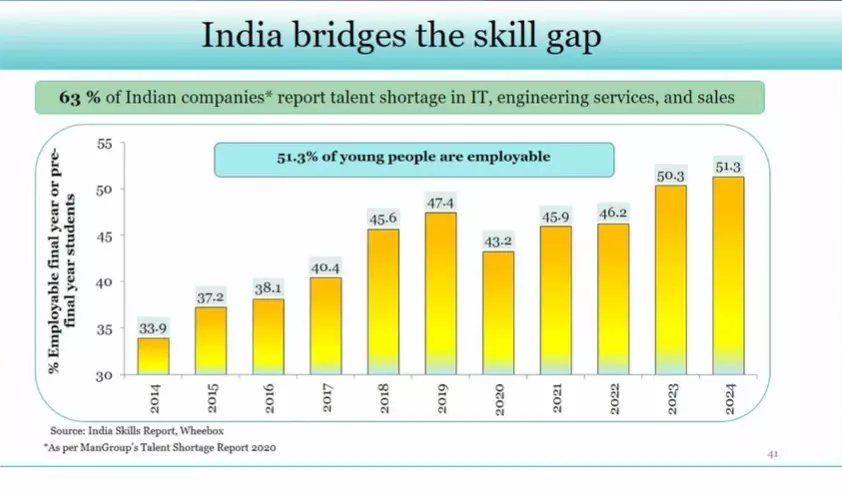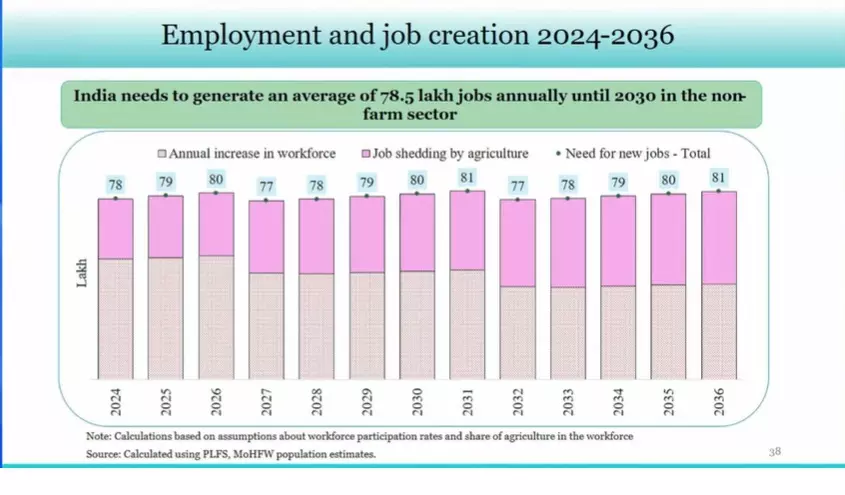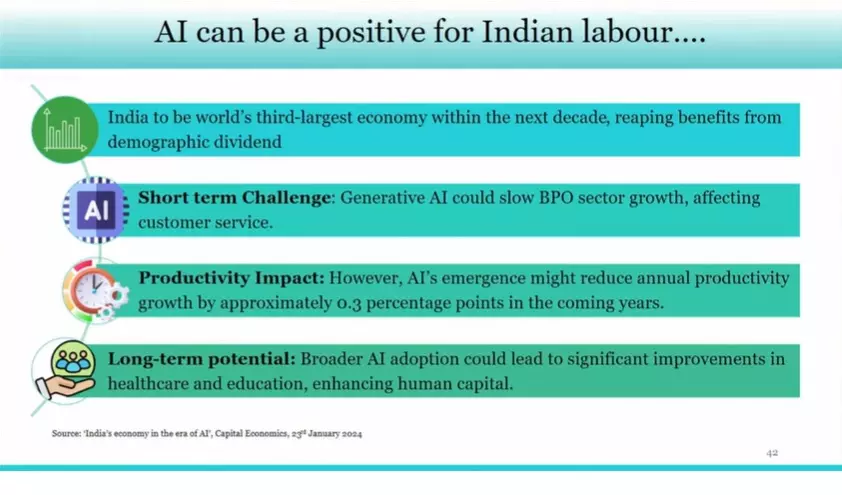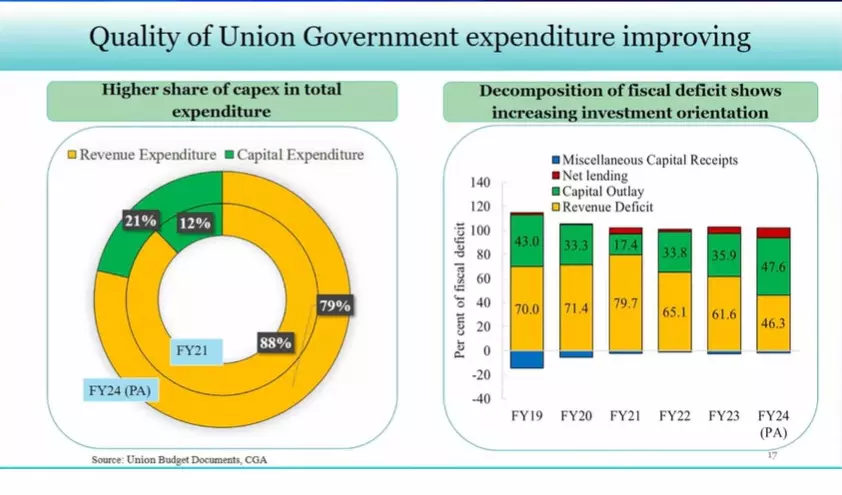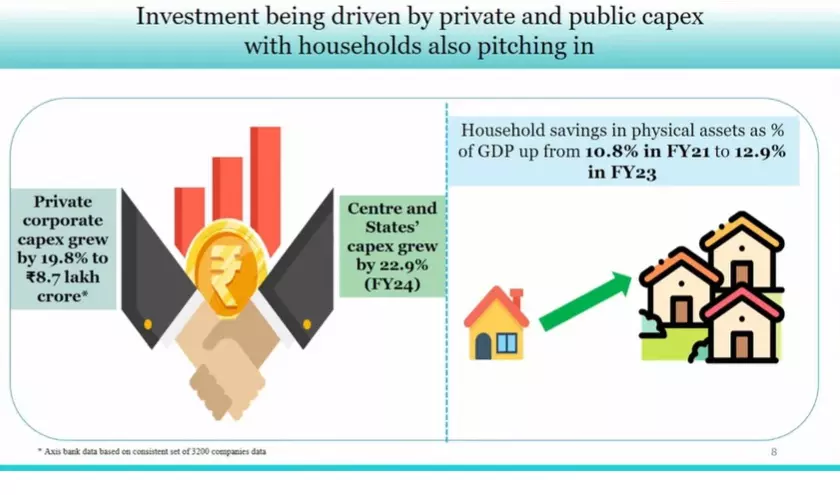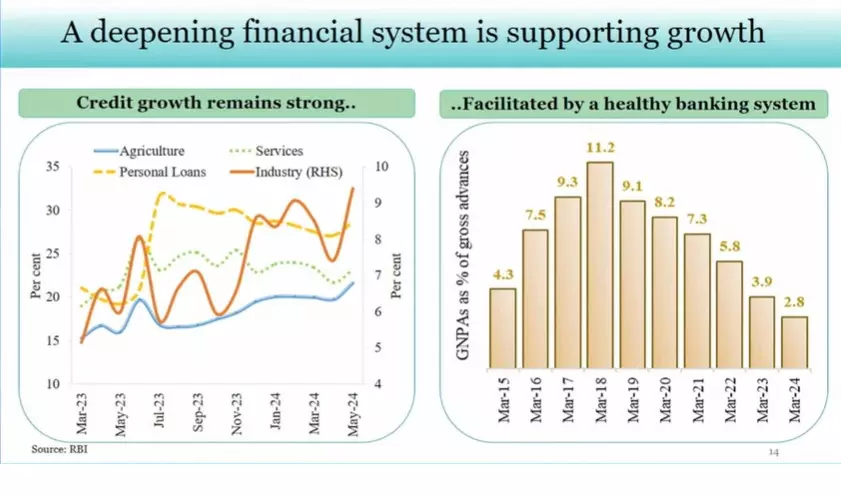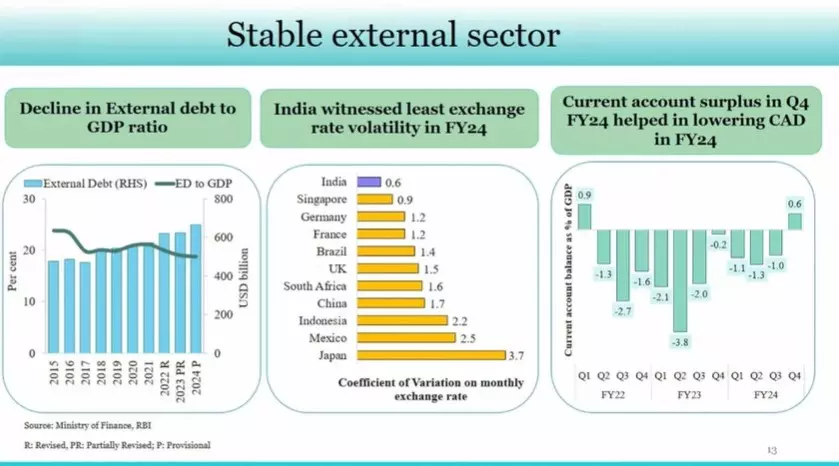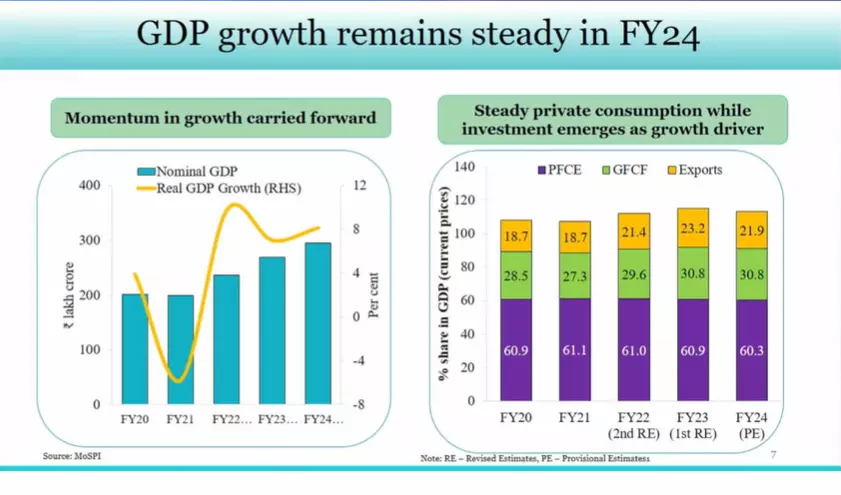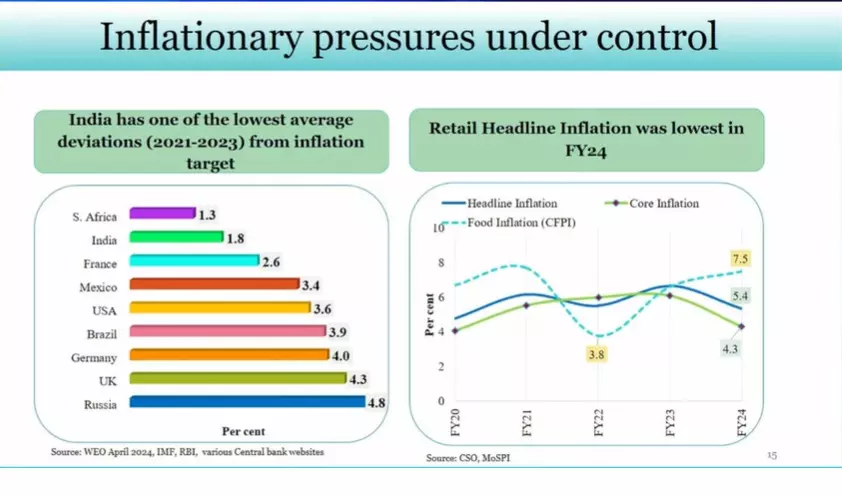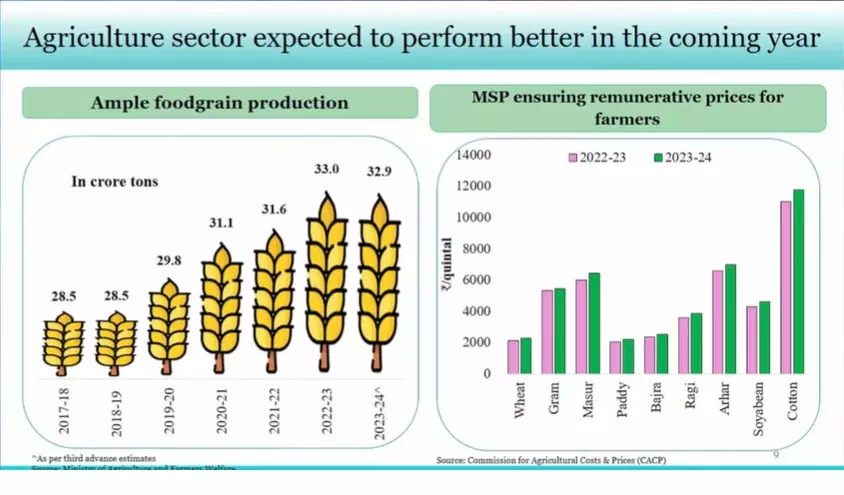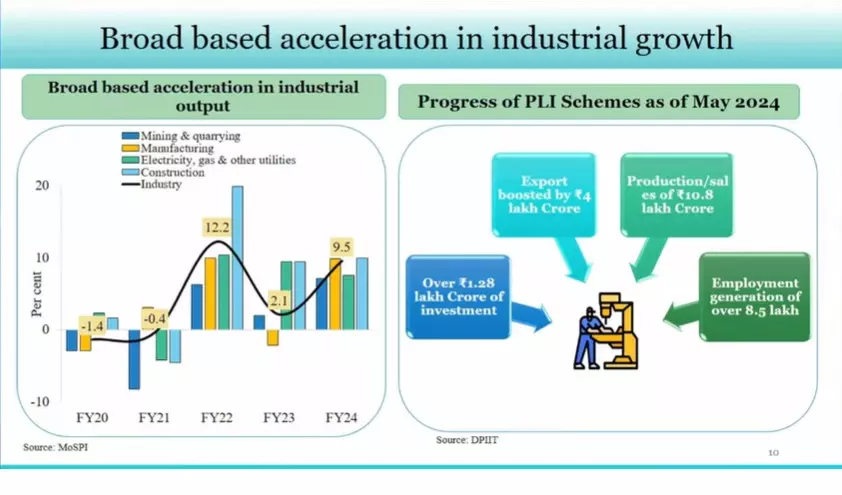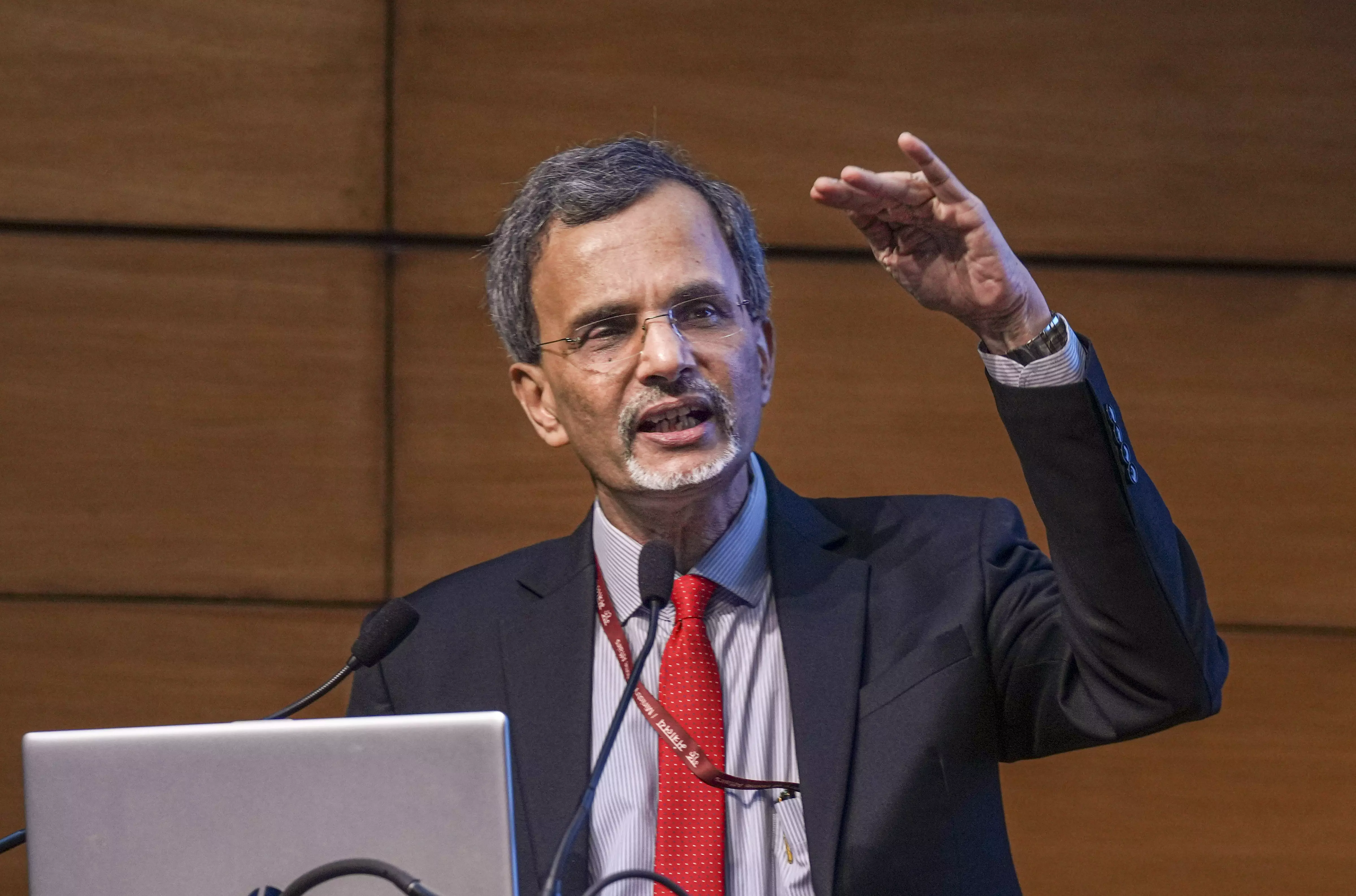
LIVE | What Economic Survey says on GDP, inflation, and more
The growth estimated by the Economic Survey, ahead of the Union Budget, is in line with the International Monetary Fund’s estimate of 7 per cent

Finance Minister Nirmala Sitharaman tabled the Economic Survey 2023-24 in Parliament on Monday (July 22), ahead of the Union Budget on Tuesday. The Survey is authored by Chief Economic Advisor V Anantha Nageswaran and his team.
Following are the highlights of the document:
- Economic growth projected at 6.5-7% in FY25 versus 8.2% in 2023-24
- Unprecedented third popular mandate of Modi government signals political, policy continuity
- Domestic growth drivers supported economic growth in FY24 despite uncertain global economic performance
- Indian economy on a strong wicket and stable footing, demonstrating resilience in the face of geopolitical challenges
- To sustain post-pandemic recovery, there has to be heavy lifting on the domestic front
- Reaching agreements on key global issues like trade, investment and climate, has become extraordinarily difficult
- Short-term inflation outlook benign, but India faces persistent deficit in pulses and consequent price pressures
- Expectations of normal monsoon, and moderating global prices of imports give credence to benign inflation projections by RBI
- Hardships caused by higher food prices for poor and low-income consumers can be handled through direct benefit transfers or coupons for specified purchases valid for appropriate durations
- Ways suggested to explore whether India’s inflation targeting framework should target the inflation rate excluding food items
- Escalation in geopolitical conflicts and its impact may influence RBI’s monetary policy stance
- Outlook for India’s financial sector appears bright
- As financial sector undergoes critical transformation, it must brace for likely vulnerabilities originating globally or locally
- Healthier corporate and bank balance sheets will further strengthen private investment
- India’s policy adeptly steered through challenges, ensuring price stability despite global uncertainties
- Tax compliance gains, expenditure restraint, and digitisation help India achieve fine balance in govt's fiscal management
- Capital markets becoming prominent in India's growth story; market resilient to global geopolitical, economic shocks
- AI casts a huge pall of uncertainty over the impact on workers across all skill levels
- Increased FDI inflows from China can help India enhance participation in global supply chain, boost exports
- As much as 54 pc of disease burden due to unhealthy diets; need transition towards balanced, diverse diet
- Remittances to India to grow at 3.7 pc to USD 124 billion in 2024, 4 pc in 2025 to reach USD 129 billion.
The Economic Survey is an annual document presented by the government ahead of the Union Budget to review the state of the economy.
The document also provides an overview of the short-to-medium-term prospects of the economy.
The Economic Survey is prepared by the Economic Division of the Department of Economic Affairs in the Ministry of Finance under the supervision of the chief economic adviser.
(Follow our Live updates below)
Live Updates
- 22 July 2024 3:33 PM IST
Use of digital system to better target fertiliser subsidy
Economic Survey has prescribed for better targeting of fertiliser subsidy using 'Agri Stack' digital system to ensure that a fixed quantity of subsidised nutrients is sold to only identified farmers based on parameters such as land ownership and cropping pattern of a particular district.
It also suggested direct transfer of fertilisers subsidy to farmers through E-RUPI, a digital payment mechanism.
Initially, the survey suggested that this system should be used as a pilot in one district of few states.
As per the interim Budget presented in February, the allocation for fertiliser subsidy is Rs 1.64 lakh crore for 2024-25 fiscal as against the revised estimates of Rs 1.89 lakh crore for the preceding financial year.
“Agri Stack is the digital foundation set up by the government to make it easier to bring various stakeholders together to improve agriculture in India and enable better outcomes and results for the farmers by using data and digital services,” it said.
The survey noted that the Agri Stack is now fairly well-developed in major Indian states and can provide the right tool through which the fertiliser subsidy might be better targeted.
“This will ensure that subsidised fertilisers are sold to only those identified as farmers or authorised by the farmer, and the quantity of subsidised fertiliser is fixed based on parameters such as land ownership and prominent crops of the district (comprising at least 70 per cent of sown area in a season),” the document said.
The parameters could be later refined based on crop grown and soil nutrient status (in convergence with the soil health card scheme). Provisions might be made to provide top-up entitlement in case of crop damage or calamities caused by volatilities in weather conditions.
“E-RUPI, a seamless one-time payment mechanism, can be utilised to provide the necessary subsidy to the farmer directly. This system ensures that the subsidy can only be used through registered PoS devices at authorised fertiliser outlets,” the survey said.
In case a farmer purchases a quantity of fertilisers that is less than their entitlement, the survey said the remaining subsidy can be used to purchase other agricultural inputs, such as seeds and pesticides, also sold at these outlets.
“Any unused subsidy at the end of the year can also be converted into a small savings instrument in the farmer's name at a post office. This system not only streamlines the subsidy distribution process but also prevents the misuse of subsidies for non-agricultural purposes,” it said.
This will give an incentive to the farmer not to use excessive urea on account of being cheaper than the other NPK fertiliser and may lead to balanced use of fertilisers as per the requirement of the crop and soil.
“Fertiliser administration reforms have been carried out in other countries, wherein the fertiliser requirement has been based on standard norms. In India, as it involves a paradigm shift and fertiliser is a sensitive subject, it may be prudent to carry out pilots in one district of a few states, which have relatively robust and well-developed agri-stack systems,” the survey said.
Based on the results of these pilots, the decision on the future mode of fertiliser subsidy administration could be made, considering all the relevant factors.
At present, urea is being provided to the farmers at a statutorily notified Maximum Retail Price (MRP) of Rs 242 per 45 kg bag of urea (exclusive of charges towards neem coating and taxes as applicable).
The difference between the delivered cost of urea at farm gate and net market realisation by the urea units is given as subsidy to the urea manufacturer/importer by the Government of India.
For non-urea, subsidy rates of P&K (potassic and phosphatic) fertilisers are under the Nutrient Based Subsidy (NBS) scheme so that these fertilisers are made available at affordable prices to the farmers.
Under the fertiliser DBT (direct benefit transfer) system, 100 per cent subsidy on various fertiliser grades is released to the fertiliser companies on the basis of actual sales made by the retailers to the beneficiaries.
Sale of all subsidised fertilisers to farmers/buyers is made through point of sale (PoS) devices installed at each retailer shop and the beneficiaries are identified through Aadhaar Card, KCC, and Voter Identity Card, etc.
- 22 July 2024 3:30 PM IST
Coupons or direct cash transfer to poor to deal with food inflation
The RBI should stop looking at food inflation in deciding interest rates and the government should explore giving coupons or direct cash transfer to poor to deal with higher food prices, the pre-Budget economic survey said on Monday.
While the inflation rate has moderated in recent months, the RBI has refrained from cutting benchmark interest rates -- which decide the rate at which home, personal and corporate loans are given by banks -- citing elevated food inflation.
India introduced the inflation-targeting framework in 2016 under which the Reserve Bank of India (RBI) is mandated to keep retail inflation at 4 per cent, with a margin of 2 per cent on either side.
The benchmark policy rates are decided bi-monthly by the RBI on the basis of movement in consumer price index, which includes food, fuel, manufactured goods and select services.
"India's inflation targeting framework should consider targeting inflation, excluding food. Higher food prices are, more often, not demand-induced but supply-induced," the Economic Survey 2023-24 said.
While retail inflation, measured by the movement in consumer price index, was at 5.08 per cent in June, food inflation was 9.36 per cent.
The RBI has kept interest rates unchanged since February 2023 on inflationary concerns.
RBI Governor Shaktikanta Das in June had said that at the current juncture, the uncertainties related to the food price outlook warrant close monitoring, especially their spillover risks to headline inflation.
Stating that monetary policy only helps in containing demand-side price pressure, the Survey said deploying them to deal with inflation caused by supply constraints may be counterproductive.
"Therefore, it is worth exploring whether India's inflation targeting framework should target the inflation rate excluding food. Hardships caused by higher food prices for poor and low-income consumers can be handled through direct benefit transfers or coupons for specified purchases valid for appropriate durations," the Survey said.
The core or manufactured inflation fell to a four-year low in 2023-24, while appropriate administrative actions, including dynamic stock management, open market operations, subsidised provision of essential food items and trade policy measures, helped mitigate food inflation to a great extent.
The expectation of a normal monsoon and moderating global prices of key imported items give credence to the benign and range-bound inflation projections for India made by the Reserve Bank of India and the International Monetary Fund.
"Beyond this, the medium to long-term inflation outlook will be shaped by the strengthening of price monitoring mechanisms and market intelligence as well as focussed efforts to increase the domestic production of essential food items like pulses and edible oils for which India has a great degree of import dependence," the Survey said.
The RBI projects retail inflation for 2024-25 at 4.5 per cent, lower than 5.4 per cent in the last fiscal.
- 22 July 2024 3:05 PM IST
States should reduce compliance burden of MSMEs
India's micro, small and medium enterprises continue to face "extensive regulation" and compliance requirements, apart from major bottlenecks in access to affordable and timely funding being one of the "core concerns", the Economic Survey said on Monday.
Asserting that further reduction in the compliance burden for MSMEs will considerably improve their growth prospects, the Survey for 2023-24 tabled in Parliament recommended "progressively easing the compliance requirements with a single-window mechanism for clearances, digitisation of processes and equipping MSMEs to handle these processes with ease".
It also called for providing grassroots-level facilitation to ensure market access to MSME products.
The Survey highlighted that the management bandwidth in MSMEs to grow business, seek new markets, get funding, and hire labour is limited, and this limited bandwidth is spent disproportionately on compliance.
"Whereas the Union government frames the rules, the implementation or supervision is in the hands of Inspectors and Supervisors who come from the relevant departments in the states. This is where senior levels of bureaucracies at the Centre and states can and should collaborate to make it easier for businesses to comply without being squeezed out of time and other resources," it asserted.
Emphasising that threshold-based concessions and exemptions create the unintended effect of incentivising enterprises to cap their sizes below the thresholds, the Survey recommended that these must have sunset clauses.
MSMEs continue to face extensive regulation and compliance requirements and face significant bottlenecks with access to affordable and timely funding being one of the core concerns, it stated.
Further, many MSMEs struggle to secure the necessary funds to start, operate, or expand their business due to a variety of reasons including lack of collateral or credit history, high interest rates, complex documentation requirements, and long processing times, etc., the Survey recommended..
Strengthening India's MSME sector is central to the country's growth in the coming years. MSMEs are the backbone of the Indian economy, contributing approximately 30 per cent of its GDP, 45 per cent of manufacturing output, and providing employment to 11 crore of the population.
To boost the growth of the MSME sector, the government has introduced initiatives such as the allocation of 5 lakh crore Emergency Credit Line GuaranteeScheme (ECLGS) for businesses, including MSMEs; equity infusion of 50,000 crore through the MSME Self-Reliant India Fund; New revised criteria for the classification of MSMEs; among others.
These initiatives have been formulated keeping in mind the key challenges the sector faces, primarily for access to timely and affordable credit. - 22 July 2024 3:04 PM IST
Defaults worth Rs 10.2 L Cr settled at pre-admission of insolvency cases since 2016
Defaults worth Rs 10.2 lakh crore have been settled at the stage of pre-admission of insolvency cases since the inception of IBC in 2016, and more than one-fifth of the companies undergoing resolution process are from the real estate space, the Economic Survey said on Monday.
Also, in the past six years since FY18, the IBC (Insolvency & Bankruptcy Code) has enabled over Rs 3 lakh crore recovery for banks, which was much more than what the lenders had recovered through previous mechanisms of Lok Adalats, DRTs, and the SARFAESI Act, it said.
Since the implementation of IBC in 2016, a total of 31,394 corporate debtors cases "involving a value of Rs 13.9 lakh crore have been disposed of (including pre-admission case disposals) as of March 2024", said the Survey tabled in Parliament by Finance Minister Nirmala Sitharaman.
The loss of control immediately after the beginning of the resolution process has led debtors settle with creditors as soon as the applications are filed with the National Company Law Tribunal (NCLT).
“A singularly notable fact is that Rs 10.2 lakh crore of underlying defaults were addressed at the pre-admission stage. This change in debtor behaviour has been a big boon for banks and other lending institutions,” it said, adding the government has “taken several measures to improve the insolvency ecosystem”.
The IBC has created an “optimal incentive-disincentive mix” to facilitate above-board and transparent dealings in creditor-debtor relations, it said.
As of March 2024, over 1,500 real estate companies were admitted to the insolvency resolution process under the IBC, accounting for a 21 per cent of total admissions, said the Economic Survey.
“One in four cases settled after admission was also from this sector. Of the 891 corporate debtors resolved, 133 were real estate companies, forming 15 per cent of the companies resolved,” it said.
As of March 2024, NCLT has facilitated the closure of 4,131 corporate insolvency resolution processes (CIRP).
The Survey said: “3,171 corporate debtors have been rescued, of which 947 cases have been resolved through approved resolution plans, which brought in a realisable value of Rs 3.36 lakh crore. In the resolved cases, the creditors recovered approximately 32 per cent of their claims.”
This amounted to a recovery of 85 per cent of the fair value and 162 per cent of the liquidation value of assets.
Now IBC is the dominant recovery route for SCBs (scheduled commercial banks), the Survey said.
Over 3,000 businesses have emerged out of the CIRP, with continued business operations extending the productive use of resources trapped due to financial distress in these corporate debtors.
The firms that went through the resolution process have witnessed a significant improvement in their performance in terms of increase in tangible assets and average capex in the post-resolution period compared to the pre-resolution period.
“The aggregate market valuation of resolved firms rose from around Rs 2 lakh crore in the pre-resolution phase to Rs 6 lakh crore in the post-resolution phase,” it said.
Also, there is a substantial increase in total employment and around a 50 per cent increase in the average employee expenses in the resolved firms (listed) in the three years post-resolution.
“It is hard to find another policy measure that has created winners,” the latest Economic Survey said.
As of March this year, 2,476 CIRPs ended in liquidation as they failed to find a buyer within the stipulated time frame.
A total of 586 firms were dissolved at the end of the liquidation process, releasing whatever resources were needed for alternate uses.
The Survey also said that the government has strengthened the NCLTs, regarding infrastructure, increasing its strength by filling vacancies and proposing an integrated IT platform.
Presently, the NCLT has 15 benches spread across the country with the Principal Bench at New Delhi.
“The IBC has established itself as an indispensable component of the asset recovery and reconstruction market. In the process, it has forever changed the credit market landscape in the country for good,” the Survey said.
The IBC has provided an avenue for corporate debtors to resolve their debt and get an honourable exit from failed business endeavours.
It has promoted “ease of doing business and encouraging entrepreneurship”, the Survey said, adding, “The Code has established itself as an effective solution for addressing banks’ stress by aiding in significantly reducing GNPAs and helping rescue failing corporate debtors.”


